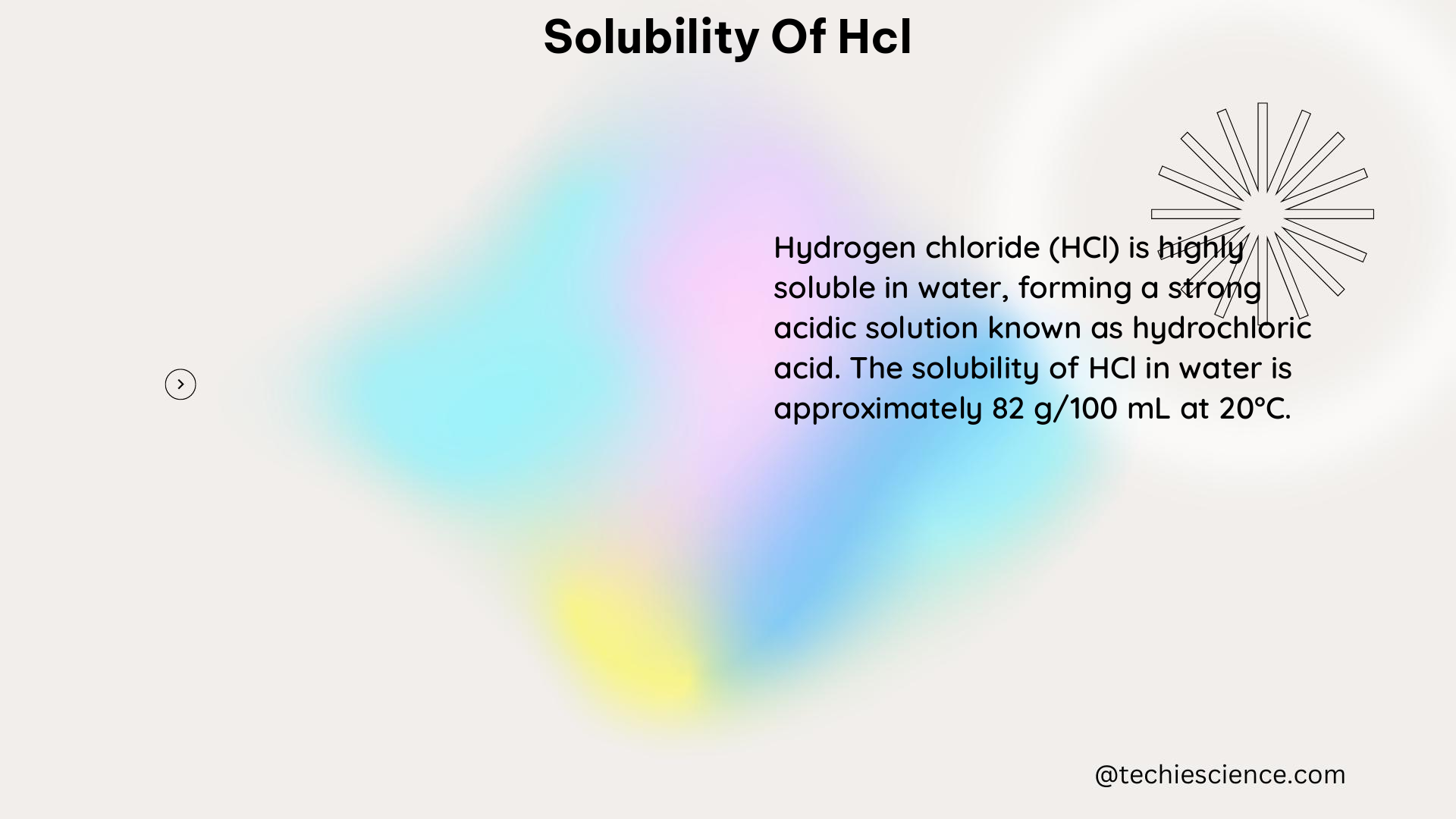Hydrogen chloride (HCl) is a widely used reagent in various chemical reactions, and understanding its solubility in different solvents is crucial for chemists and researchers. This comprehensive guide will delve into the intricate details of HCl’s solubility, providing a wealth of technical information to aid science students and professionals.
Understanding the Solubility of HCl in Water
The solubility of HCl in water is well-documented, with a maximum solubility of around 37% at room temperature. This high solubility is due to the complete dissociation of HCl into hydrogen ions (H+) and chloride ions (Cl-) in water, as described by the following equation:
HCl(g) + H2O(l) ⇌ H3O+(aq) + Cl-(aq)
The equilibrium constant (Kc) for this reaction at 25°C is approximately 1.8 × 10^6, indicating a highly favorable reaction towards the formation of the hydronium and chloride ions.
The water solubility of HCl is also temperature-dependent, with the solubility increasing as the temperature decreases. At 0°C, the solubility of HCl in water is reported to be 823 g/L, as mentioned in the Dow Europe S.A. report.
Solubility of HCl in Methanol

The solubility of HCl in methanol (CH3OH) is relatively high compared to its solubility in water. According to the data discussed on the Sciencemadness Discussion Board, the solubility of HCl in methanol is approximately 54.6 g/100 g solution at -10°C and 51 g/100 g solution at 20°C.
The higher solubility of HCl in methanol can be attributed to the polarity and hydrogen-bonding capabilities of the methanol molecule. The hydroxyl group (-OH) in methanol can form hydrogen bonds with the chloride ion (Cl-) from the dissociated HCl, enhancing the solubility.
Additionally, the larger volume of methanol required to dissolve the same mass of HCl, as mentioned by DJF90 on the Sciencemadness Discussion Board, also contributes to the higher solubility compared to water.
Solubility of HCl in Ethanol
The solubility of HCl in ethanol (C2H5OH) is also relatively high, with Aldrich reporting a 1.25M solution of HCl in ethanol. This corresponds to a solubility of approximately 45 g/100 g solution at room temperature.
Similar to methanol, the polarity and hydrogen-bonding capabilities of the ethanol molecule play a role in the enhanced solubility of HCl compared to water. The hydroxyl group (-OH) in ethanol can form hydrogen bonds with the chloride ion (Cl-), facilitating the dissolution of HCl.
Solubility of HCl in Diethyl Ether
The solubility of HCl in diethyl ether (C2H5OC2H5) is also noteworthy, with Aldrich reporting a 2.2M solution of HCl in ether at room temperature.
The relatively high solubility of HCl in ether can be attributed to the polarity of the ether molecule and its ability to solvate the chloride ion (Cl-) through dipole-ion interactions. Additionally, the low dielectric constant of ether (4.3 at 20°C) compared to water (80.1 at 20°C) contributes to the enhanced solubility of the ionic HCl species.
Factors Affecting the Solubility of HCl
The solubility of HCl in various solvents is influenced by several factors, including:
-
Polarity of the Solvent: Polar solvents, such as water, methanol, and ethanol, generally exhibit higher solubility for HCl due to their ability to solvate the ionic species (H+ and Cl-) through dipole-ion interactions and hydrogen bonding.
-
Dielectric Constant of the Solvent: Solvents with lower dielectric constants, like ether, are better able to stabilize the ionic species of HCl, leading to higher solubility.
-
Temperature: The solubility of HCl generally increases with decreasing temperature, as observed in the case of methanol and water.
-
Vapor Pressure of HCl: HCl has a relatively high vapor pressure of 31.33 hPa at 20°C, as reported by BASF AG. This high vapor pressure can affect the solubility and handling of HCl, as it can lead to the formation of hazardous fumes.
Practical Considerations and Safety Precautions
When working with HCl, it is essential to consider the following safety precautions:
- Wear appropriate personal protective equipment (PPE), such as gloves, safety goggles, and a lab coat, to minimize exposure.
- Perform experiments in a well-ventilated area or under a fume hood to prevent the inhalation of HCl vapors.
- Properly dispose of HCl waste according to local regulations and environmental guidelines.
- Familiarize yourself with the hazards and first-aid measures associated with HCl exposure.
Conclusion
The solubility of hydrogen chloride (HCl) in various solvents is a crucial topic in chemistry, with significant implications for chemical reactions and the handling of this hazardous substance. This comprehensive guide has provided detailed information on the solubility of HCl in water, methanol, ethanol, and diethyl ether, along with the factors that influence its solubility and important safety considerations. By understanding the intricacies of HCl’s solubility, science students and professionals can make informed decisions and conduct their work safely and effectively.
References:
- Sciencemadness Discussion Board, “Does anyone have solubility data of HCl in various solvents (Methanol, Ethanol, Ether)?”, accessed on June 17, 2024, http://www.sciencemadness.org/talk/viewthread.php?tid=84854.
- HYDROGEN CHLORIDE CAS N°: 7647-01-0, accessed on June 17, 2024, https://hpvchemicals.oecd.org/UI/handler.axd?id=e1fe4ef3-e3d4-4f3d-9a58-8bf2f8296b61.
- SOLUBILITY DATA SERIES, accessed on June 17, 2024, https://srdata.nist.gov/solubility/IUPAC/SDS-42/SDS-42.pdf.

The lambdageeks.com Core SME Team is a group of experienced subject matter experts from diverse scientific and technical fields including Physics, Chemistry, Technology,Electronics & Electrical Engineering, Automotive, Mechanical Engineering. Our team collaborates to create high-quality, well-researched articles on a wide range of science and technology topics for the lambdageeks.com website.
All Our Senior SME are having more than 7 Years of experience in the respective fields . They are either Working Industry Professionals or assocaited With different Universities. Refer Our Authors Page to get to know About our Core SMEs.